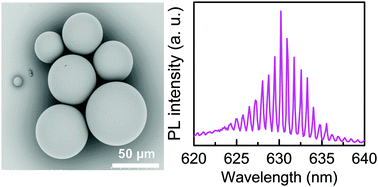Protein-based microsphere biolasers fabricated by dehydration†
Abstract
Biolasers made of biological materials have attracted considerable research attention due to their biocompatibility and biodegradability, and have the potential for biosensing and biointegration. However, the current fabrication methods of biolasers suffer from several limitations, such as complicated processing, time-consuming and environmentally unfriendly nature. In this study, a novel approach with green processes for fabricating solid-state microsphere biolasers has been demonstrated. By dehydration via a modified Microglassification™ technology, dye-doped bovine serum albumin (BSA) droplets could be quickly (less than 10 minutes) and easily changed into solid microspheres with diameters ranging from 10 μm to 150 μm. The size of the microspheres could be effectively controlled by changing either the concentration of the BSA solution or the diameter of the initial droplets. The fabricated microspheres could act as efficient microlasers under an optical pulse excitation. A lasing threshold of 7.8 μJ mm−2 and a quality (Q) factor of about 1700 to 3100 were obtained. The size dependence of lasing characteristics was investigated, and the results showed a good agreement with whispering gallery mode (WGM) theory. Our findings contribute an effective technique for the fabrication of high-Q factor microlasers that may be potential for applications in biological and chemical sensors.



 Please wait while we load your content...
Please wait while we load your content...